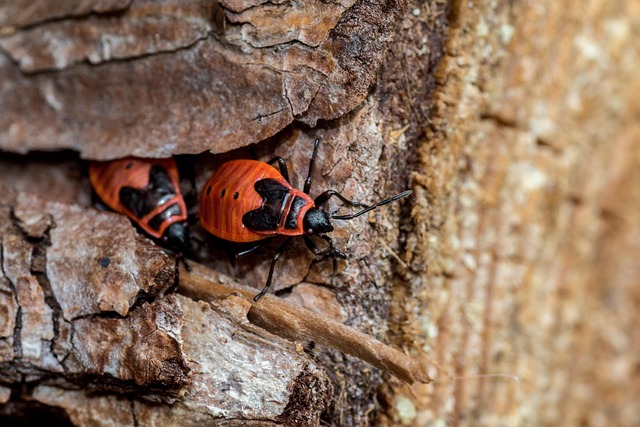Commercial sowbug extermination requires understanding these insects' preferred habitats, which are damp, cluttered areas with organic debris. To combat them, identify entry points like gaps around pipes and doors, seal them, maintain strict sanitation, address moisture issues, and manage debris regularly. A multi-faceted approach including cleaning and targeted treatments recommended by pest control professionals is key to effective commercial sowbug extermination.
In many commercial spaces, sowbugs can proliferate, causing unsanitary conditions and structural damage. This guide delves into effective strategies for commercial sowbug extermination by addressing their primary habitat requirements: moisture and debris. Understanding where these creatures thrive and how to disrupt their breeding cycle is key to successful prevention. Learn about identifying entry points, implementing robust moisture control measures, and adopting efficient debris management techniques to deter sowbug populations once and for all.
Understanding Sowbugs and Their Habitat
Sowbugs, scientifically known as Merisimoteta spp., are small, wingless insects that thrive in damp environments. They are often found in commercial establishments like warehouses, basements, and greenhouses due to their preference for moist conditions. These pests can quickly multiply and cause significant damage by feeding on various organic materials, including textiles, paper products, and plant debris. Understanding where sowbugs harbor and what attracts them is crucial for effective commercial sowbug extermination.
Their habitat typically includes areas with high moisture levels, such as poorly ventilated spaces, leaking pipes, or places where water collects. Sowbugs are also attracted to organic matter accumulation, making cluttered environments ideal breeding grounds. By reducing moisture sources and eliminating debris, commercial properties can significantly deter sowbug populations. This proactive approach not only minimizes damage but also prevents the need for extensive commercial sowbug extermination measures.
Identifying Common Entry Points for Sowbugs in Commercial Spaces
In commercial spaces, identifying common entry points for sowbugs is a critical step in effective commercial sowbug extermination. These pests are known to infiltrate through various openings and cracks, often seeking moisture and organic debris. Common entry points include gaps around pipes, wires, doors, and windows. Additionally, seams in floorboards, walls, and ceilings can provide easy access. Regular inspections should be conducted to pinpoint these areas, allowing for targeted treatment strategies.
By understanding where sowbugs are entering the premises, facility managers can implement preventive measures to reduce their population. Sealing entry points with appropriate materials, such as caulk or metal screens, can significantly hinder the pests’ access. Maintaining excellent sanitation practices by promptly cleaning up debris and spills is also crucial. This approach not only deters sowbugs but also promotes a healthier and more hygienic environment for both employees and customers.
Implementing Moisture Control Measures
Implementing effective moisture control measures is a strategic step in commercial sowbug extermination. These pests thrive in humid environments, so reducing moisture levels can significantly deter their populations. Commercial facilities should focus on identifying and addressing sources of excess humidity. This might involve fixing leaky pipes, improving ventilation systems, or installing dehumidifiers in affected areas. By maintaining lower humidity, you create an inhospitable environment for sowbugs, making it easier to manage and control their presence.
Regular inspections are key to successful moisture control. Checking for water stains, condensation, or dampness in walls, floors, and hidden spaces helps pinpoint problem areas. Addressing these issues promptly prevents future sowbug infestations. Additionally, keeping facilities clean and free of debris ensures there are fewer hiding spots for these pests, further aiding in commercial sowbug extermination efforts.
Effective Debris Management Strategies to Deter Sowbug Populations
In the quest to reduce sowbug populations, effective debris management is key. Sowbugs thrive in environments filled with organic matter and clutter, so keeping areas clean and well-organized can significantly deter their presence. Regularly clearing away leaves, grass clippings, and other plant debris from your property, especially around entry points like doors and windows, helps eliminate hiding places for sowbugs. Implementing a strict no-clutter policy, particularly in basements and attics, further restricts access to food sources and shelters, making it harder for these pests to establish and grow their populations.
For commercial sowbug extermination efforts, taking proactive steps to manage debris is crucial alongside chemical interventions. Professional pest control services often recommend a multi-faceted approach that combines regular cleanouts with specialized treatments tailored to target sowbugs. By addressing the environmental factors that encourage sowbug proliferation, businesses can achieve lasting results in maintaining a sowbug-free environment and ensure customer satisfaction.
By understanding sowbugs’ habitat preferences and implementing targeted strategies to reduce moisture and debris, commercial spaces can effectively deter these pests. Maintaining a dry environment and minimizing clutter creates an inhospitable atmosphere for sowbugs, significantly contributing to successful commercial sowbug extermination efforts. These simple yet powerful measures ensure a more comfortable, pest-free space for business operations.
